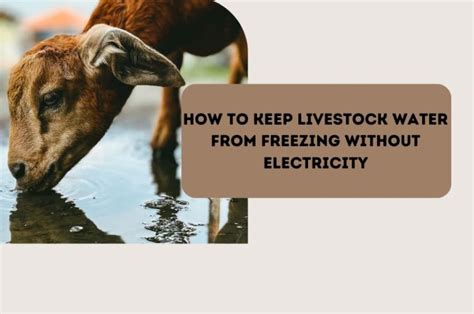How To Keep Livestock Water From Freezing Without Electricity
Ronan Farrow
Apr 01, 2025 · 3 min read

Table of Contents
How to Keep Livestock Water from Freezing Without Electricity
Winter's harsh conditions can pose a significant challenge to livestock farmers, especially when it comes to ensuring a consistent supply of fresh, unfrozen water for their animals. Power outages can exacerbate the problem, leaving you scrambling for solutions. Fortunately, there are several reliable methods to keep livestock water from freezing without relying on electricity. This guide explores effective and practical strategies to protect your animals from dehydration during freezing temperatures.
Understanding the Problem: Why Preventing Frozen Water is Crucial
Dehydration is a serious threat to livestock in freezing weather. Animals need consistent access to water to maintain their body temperature, especially when dealing with the cold. Frozen water sources lead to reduced water intake, resulting in decreased milk production, weight loss, and potentially even death in severe cases. Preventing frozen water is crucial for the health and well-being of your animals.
Proven Methods to Keep Livestock Water Unfrozen
Here are several proven methods you can employ to keep your livestock's water supply flowing freely, even when the mercury plummets:
1. Insulated Water Tanks and Troughs:
-
The Basics: Investing in well-insulated water tanks and troughs is a proactive and highly effective strategy. Insulation significantly slows down the rate at which water freezes. Consider tanks and troughs made of materials with inherent insulating properties like double-walled plastic or stainless steel with added insulation.
-
DIY Insulation: If you have existing tanks, you can improve their insulation by adding layers of materials like straw, hay (avoiding moldy hay), or even old blankets wrapped around the tank. This creates an air pocket that acts as an insulator.
2. Submersible Water Heaters (with backup power):
-
Important Note: While the title specifies without electricity, submersible heaters offer a solution if you have a reliable backup power source such as a generator or solar panel system. This ensures a continuous supply of unfrozen water, even during power outages.
-
Safety First: Always follow the manufacturer's instructions carefully and ensure the heater is appropriately sized and installed to avoid overheating or fire hazards.
3. Floating Waterers:
-
How They Work: These innovative devices utilize the principle of buoyancy. The water container is partially submerged, reducing the surface area exposed to the freezing air. The water in contact with the air can freeze, but the submerged portion remains liquid, providing a continuous supply.
-
Effectiveness: The effectiveness of floating waterers depends on the severity of the weather conditions. They are most suitable for milder freezing temperatures.
4. Stock Tank De-icers (non-electric):
-
Alternative Heating: This method typically involves using propane or other non-electric heating elements designed specifically for stock tanks. Always follow safety precautions for handling propane or other fuel sources.
-
Cost Considerations: While effective, propane-based systems incur ongoing costs related to fuel replenishment.
5. Frequent Water Changes:
- Diligence is Key: In milder freezing conditions, frequently changing the water in your livestock's troughs can be a viable strategy. This involves removing the frozen water and replacing it with fresh, warmer water. This is labor-intensive, however, and only suitable when temperatures aren't severely cold.
6. Protected Locations:
- Shelter from the Wind: Positioning water sources in a sheltered location, out of the direct wind, helps slow down freezing. A barn or other structure offering some protection can make a significant difference.
Choosing the Right Method: Factors to Consider
The best method for keeping livestock water from freezing depends on several factors:
-
Severity of winter conditions: The average winter temperatures in your area determine the robustness of the solution needed.
-
Livestock type and number: Different animals have different water requirements, so the size of your water supply needs to match.
-
Budget: The cost of various solutions can range widely, from inexpensive insulation to more expensive heating systems.
-
Time commitment: Some methods, like frequent water changes, require more hands-on effort than others.
By carefully considering these factors, you can select the most appropriate method to ensure your livestock's access to unfrozen water throughout the winter months. Remember, proactive planning is crucial for ensuring the well-being of your animals.
Featured Posts
Also read the following articles
| Article Title | Date |
|---|---|
| How To Keep Mice Out Of Rv In Winter | Apr 01, 2025 |
| How To Make A Partial Denture | Apr 01, 2025 |
| How To Keep House While Drowning Review | Apr 01, 2025 |
| How To Make A Bath Bomb Without Citric Acid | Apr 01, 2025 |
| How To Join Temu Class Action Lawsuit | Apr 01, 2025 |
Latest Posts
Thank you for visiting our website which covers about How To Keep Livestock Water From Freezing Without Electricity . We hope the information provided has been useful to you. Feel free to contact us if you have any questions or need further assistance. See you next time and don't miss to bookmark.
